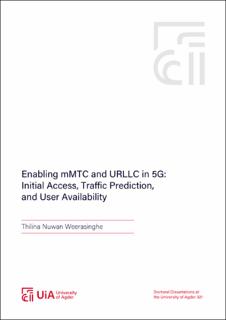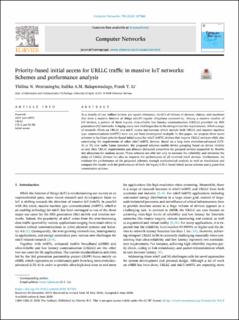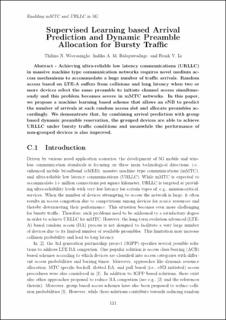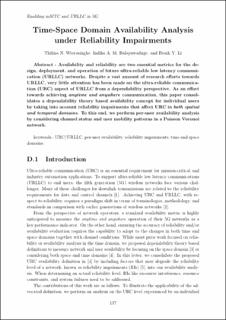| dc.contributor.advisor | Li, Frank Yong | |
| dc.contributor.author | Weerasinghe, Thilina Nuwan | |
| dc.date.accessioned | 2021-05-19T09:37:41Z | |
| dc.date.available | 2021-05-19T09:37:41Z | |
| dc.date.created | 2021-05-05T11:45:10Z | |
| dc.date.issued | 2021 | |
| dc.identifier.citation | Weerasinghe, T. N. (2021). Enabling mMTC and URLLC in 5G : Initial Access, Traffic Prediction, and User Availability [PhD. thesis]. University of Agder. | en_US |
| dc.identifier.isbn | 978-82-8427-026-5 | |
| dc.identifier.issn | 1504-9272 | |
| dc.identifier.uri | https://hdl.handle.net/11250/2755618 | |
| dc.description | Paper II is not published yet. | en_US |
| dc.description.abstract | The 5th generation (5G) mobile communication networks focus on three main technology pillars as enhanced mobile broadband (eMBB), ultra-reliable and low latency communications (URLLC), and massive machine type communications (mMTC). Among them, URLLC and mMTC introduce many novel challenging tasks for system and protocol design. This is a result of the stringent service requirements associated with URLLC and the massive number of devices that constitute mMTC. In this dissertation, we investigate three topics towards enabling mMTC and URLLC in 5G networks as stated below.
The first topic which is the main focus of this dissertation lies in proposing initial access approaches in URLLC and mMTC scenarios. Initial access plays an essential role for end device to base station communications. In fourth generation, the grant based (GB) long term evolution-advanced (LTE-A) random access procedure was adopted for initial access. However, when a large number of devices compete for scarce radio resources, the LTE-A random access procedure causes higher device collisions resulting in thereby long latency. The proliferation of devices triggered by massive Internet of things (mIoT)/mMTC deployments and the stringent access requirements of futuristic applications further exaggerates this problem. Moreover, mMTC devices typically generate small packets making the initial control message exchange in LTE-A random access a major burden. As an e ort to address these shortcomings in existing initial access procedures, this dissertation proposes both grant based and grant-free access schemes. The proposed GB schemes enable both device and resource grouping to give priority access for mMTC devices with URLLC requirements considering a large device population. Meanwhile, the proposed GF access scheme enables priority access for high priority devices based on a heterogeneous traffic arrival scenario. A two dimensional Markov model that aggregates both high and low priority traffic through a pseudo-aggregated process is developed.
Furthermore, prediction of traffic arrivals at a base station is of paramount importance for successful detection of congestion and to initiate proactive measures to minimize collisions. In reality, a base station only has information about the number of detections which does not naturally reflect the number of arrivals that caused it. Therefore, as the second topic, this dissertation presents a machine learning based traffic arrival prediction model for bursty traffic arrivals in an mMTC scenario. It relies on the detected data at the base station to learn about actual number of device arrivals and predict the occurrence of a bursty traffic arrival. Moreover, resource allocation strategies based on the predictions of the proposed model are also introduced.
On the other hand, 5G networks are envisaged to provide anytime and anywhere communications. Evaluating the availability and reliability of a network from an end user perspective appears as a vital component for benchmarking service providers. As the third topic, this dissertation presents an end user availability evaluation metric and demonstrates its applicability in a heterogeneous network for a mobile user. The proposed approach applies a dependability theory perspective for evaluating user availability by considering factors that deteriorate reliability in both space and time domains.
The performance of the proposed schemes is evaluated through analyses and extensive discrete-event simulations. In a nutshell, we believe that the schemes and analyses presented in this dissertation will advance the state-of-the-art research within the studied topics and contribute positively towards solutions for enabling URLLC and mMTC in 5G NR and beyond 5G networks. | en_US |
| dc.language.iso | eng | en_US |
| dc.publisher | University of Agder | en_US |
| dc.relation.ispartofseries | Doctoral Dissertations at the University of Agder; no. 321 | |
| dc.relation.haspart | Paper I: Weerasinghe, T. N., Balapuwaduge, I. A. M. & Li, F. Y. (2020). Priority-based initial access for URLLC traffic in massive IoT networks : Schemes and performance analysis. Computer Networks, 178: 107360. https://doi.org/10.1016/j.comnet.2020.107360. Accepted manuscript. Full-text is available in AURA as a separate file: . | en_US |
| dc.relation.haspart | Paper II: Weerasinghe, T. N., Casares-Giner, V., Balapuwaduge, I. A. M. & Li, F. Y. (Forthcoming). Priority enabled grant-free access with dynamic slot allocation for heterogeneous mMTC traffic in 5G NR networks. IEEE Transactions on Communications. Accepted manuscript. Full-text is not available in AURA as a separate file. | en_US |
| dc.relation.haspart | Paper III: Weerasinghe, T. N., Balapuwaduge, I. A. M. & Li, F. Y. (2019). Supervised Learning based Arrival Prediction and Dynamic Preamble Allocation for Bursty Traffic. The 22nd IEEE Global Internet Symposium. IEEE. https://ieeexplore.ieee.org/abstract/document/9093789. Accepted manuscript. Full-text is available in AURA as a separate file: . | en_US |
| dc.relation.haspart | Paper IV: Weerasinghe, T. N., Balapuwaduge, I. A. M. & Li, F. Y. (2019). Time-Space Domain Availability Analysis Under Reliability Impairments. IEEE Networking Letters, 1(3), 103-106. https://doi.org/10.1109/LNET.2019.2916909. Accepted manuscript. Full-text is available in AURA as a separate file: . | en_US |
| dc.title | Enabling mMTC and URLLC in 5G : Initial Access, Traffic Prediction, and User Availability | en_US |
| dc.type | Doctoral thesis | en_US |
| dc.description.version | publishedVersion | en_US |
| dc.rights.holder | © 2021 Thilina Nuwan Weerasinghe | en_US |
| dc.source.pagenumber | 169 | en_US |
| dc.source.issue | 321 | en_US |
| dc.identifier.cristin | 1908180 | |
| dc.relation.project | Norges forskningsråd: 237896 | en_US |



